You have no items in your shopping cart.
Anti-Hyaluronan synthase 1/HAS1 Antibody
Catalog Number: orb526995
| Catalog Number | orb526995 |
|---|---|
| Category | Antibodies |
| Description | Anti-Hyaluronan synthase 1/HAS1 Antibody. Tested in IF, IHC, ICC, WB applications. This antibody reacts with Human, Mouse, Rat. |
| Species/Host | Rabbit |
| Clonality | Polyclonal |
| Tested applications | ICC, IF, IHC, WB |
| Reactivity | Human, Mouse, Rat |
| Isotype | Rabbit IgG |
| Immunogen | A synthetic peptide corresponding to a sequence at the N-terminus of human Hyaluronan synthase 1/HAS1, identical to the related mouse and rat sequences. |
| Concentration | Adding 0.2 ml of distilled water will yield a concentration of 500 μg/ml. |
| Form/Appearance | Lyophilized |
| Conjugation | Unconjugated |
| MW | 70 kDa |
| UniProt ID | Q92839 |
| Storage | Maintain refrigerated at 2-8°C for up to 2 weeks. For long term storage store at -20°C in small aliquots to prevent freeze-thaw cycles. |
| Alternative names | Hyaluronan synthase 1; Hyaluronate synthase 1; Hya Read more... |
| Note | For research use only |
| Application notes | Western blot, 0.1-0.5μg/ml Immunohistochemistry (Paraffin-embedded Section), 0.5-1μg/ml Immunocytochemistry/Immunofluorescence, 2μg/ml. Add 0.2ml of distilled water will yield a concentration of 500ug/ml |
| Expiration Date | 12 months from date of receipt. |

IF analysis of HAS1 using anti-HAS1 antibody. HAS1 was detected in immunocytochemical section of U20S cell. Enzyme antigen retrieval was performed using IHC enzyme antigen retrieval reagent for 15 mins. The cells were blocked with 10% goat serum. And then incubated with 2 µg/mL rabbit anti-HAS1 Antibody overnight at 4°C. DyLight®488 Conjugated Goat Anti-Rabbit IgG was used as secondary antibody at 1:100 dilution and incubated for 30 minutes at 37°C. The section was counterstained with DAPI. Visualize using a fluorescence microscope and filter sets appropriate for the label used.
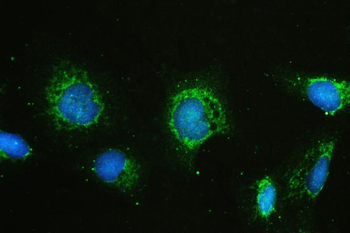
IF analysis of HAS1 using anti-HAS1 antibody. HAS1 was detected in immunocytochemical section of U20S cell. Enzyme antigen retrieval was performed using IHC enzyme antigen retrieval reagent for 15 mins. The cells were blocked with 10% goat serum. And then incubated with 2 µg/mL rabbit anti-HAS1 Antibody overnight at 4°C. DyLight®488 Conjugated Goat Anti-Rabbit IgG was used as secondary antibody at 1:100 dilution and incubated for 30 minutes at 37°C. The section was counterstained with DAPI. Visualize using a fluorescence microscope and filter sets appropriate for the label used.
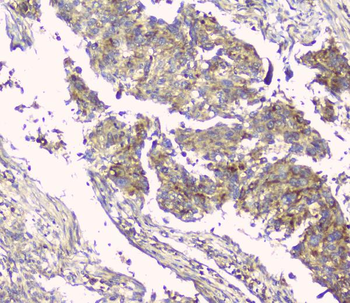
IHC analysis of HAS1 using anti-HAS1 antibody. HAS1 was detected in paraffin-embedded section of human lung cancer tissue. Heat mediated antigen retrieval was performed in citrate buffer (pH6, epitope retrieval solution) for 20 mins. The tissue section was blocked with 10% goat serum. The tissue section was then incubated with 1ug µg/ml rabbit anti-HAS1 Antibody overnight at 4°C. Biotinylated goat anti-rabbit IgG was used as secondary antibody and incubated for 30 minutes at 37°C. The tissue section was developed using Strepavidin-Biotin-Complex (SABC) with DAB as the chromogen.
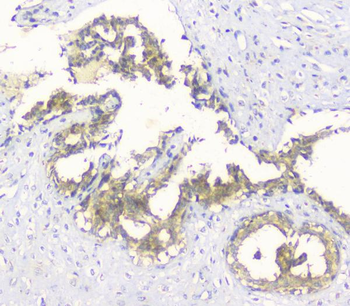
IHC analysis of HAS1 using anti-HAS1 antibody. HAS1 was detected in paraffin-embedded section of human mammary cancer tissue. Heat mediated antigen retrieval was performed in citrate buffer (pH6, epitope retrieval solution) for 20 mins. The tissue section was blocked with 10% goat serum. The tissue section was then incubated with 1ug µg/ml rabbit anti-HAS1 Antibody overnight at 4°C. Biotinylated goat anti-rabbit IgG was used as secondary antibody and incubated for 30 minutes at 37°C. The tissue section was developed using Strepavidin-Biotin-Complex (SABC) with DAB as the chromogen.
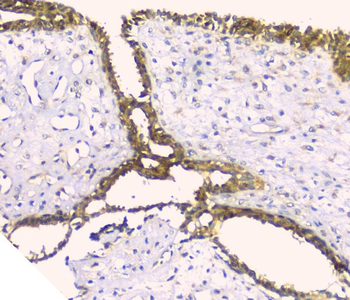
IHC analysis of HAS1 using anti-HAS1 antibody. HAS1 was detected in paraffin-embedded section of human mammary cancer tissue. Heat mediated antigen retrieval was performed in citrate buffer (pH6, epitope retrieval solution) for 20 mins. The tissue section was blocked with 10% goat serum. The tissue section was then incubated with 1ug µg/ml rabbit anti-HAS1 Antibody overnight at 4°C. Biotinylated goat anti-rabbit IgG was used as secondary antibody and incubated for 30 minutes at 37°C. The tissue section was developed using Strepavidin-Biotin-Complex (SABC) with DAB as the chromogen.
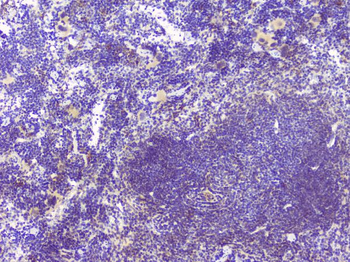
IHC analysis of HAS1 using anti-HAS1 antibody. HAS1 was detected in paraffin-embedded section of mouse spleen tissue. Heat mediated antigen retrieval was performed in citrate buffer (pH6, epitope retrieval solution) for 20 mins. The tissue section was blocked with 10% goat serum. The tissue section was then incubated with 1ug µg/ml rabbit anti-HAS1 Antibody overnight at 4°C. Biotinylated goat anti-rabbit IgG was used as secondary antibody and incubated for 30 minutes at 37°C. The tissue section was developed using Strepavidin-Biotin-Complex (SABC) with DAB as the chromogen.
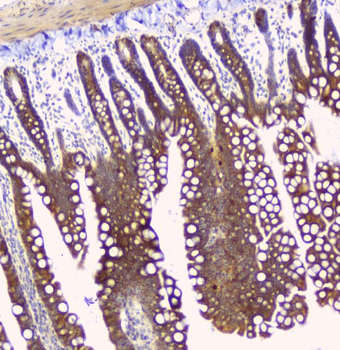
IHC analysis of HAS1 using anti-HAS1 antibody. HAS1 was detected in paraffin-embedded section of rat small intestine tissue. Heat mediated antigen retrieval was performed in citrate buffer (pH6, epitope retrieval solution) for 20 mins. The tissue section was blocked with 10% goat serum. The tissue section was then incubated with 1ug µg/ml rabbit anti-HAS1 Antibody overnight at 4°C. Biotinylated goat anti-rabbit IgG was used as secondary antibody and incubated for 30 minutes at 37°C. The tissue section was developed using Strepavidin-Biotin-Complex (SABC) with DAB as the chromogen.
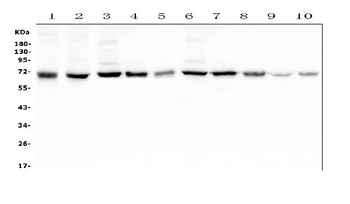
Western blot analysis of HAS1 using anti-HAS1 antibody. Electrophoresis was performed on a 5-20% SDS-PAGE gel at 70V (Stacking gel) / 90V (Resolving gel) for 2-3 hours. The sample well of each lane was loaded with 50 ug of sample under reducing conditions. Lane 1: human SHG-44 whole cell lysates, Lane 2: human THP-1 whole cell lysates, Lane 3: rat brain tissue lysates, Lane 4: rat smooth muscle tissue lysates, Lane 5: rat ovary tissue lysates, Lane 6: mouse brain tissue lysates, Lane 7: mouse smooth muscle tissue lysates, Lane 8: mouse ovary tissue lysates, Lane 9: mouse small intestine tissue lysates, Lane 10: mouse Neuro-2a whole cell lysates. After Electrophoresis, proteins were transferred to a Nitrocellulose membrane at 150mA for 50-90 minutes. Blocked the membrane with 5% Non-fat Milk/ TBS for 1.5 hour at RT. The membrane was incubated with rabbit anti-HAS1 antigen affinity purified polyclonal antibody at 0.5 µg/mL overnight at 4°C, then washed with TBS-0.1% Tween 3 times with 5 minutes each and probed with a goat anti-rabbit IgG-HRP secondary antibody at a dilution of 1:10000 for 1.5 hour at RT. The signal is developed using an Enhanced Chemiluminescent detection (ECL) kit with Tanon 5200 system. A specific band was detected for HAS1 at approximately 70KD. The expected band size for HAS1 is at 65KD.
Anti-Hyaluronan synthase 1/HAS1 Antibody [orb2610528]
ICC, IF, IHC, WB
Human, Mouse, Rat
Rabbit
Polyclonal
iFluor647
100 μgAnti-Hyaluronan synthase 1/HAS1 Antibody [orb2610529]
ICC, IF, IHC, WB
Human, Mouse, Rat
Rabbit
Polyclonal
PE
100 μgAnti-Hyaluronan synthase 1/HAS1 Antibody [orb2610530]
ICC, IF, IHC, WB
Human, Mouse, Rat
Rabbit
Polyclonal
APC
100 μgAnti-Hyaluronan synthase 1/HAS1 Antibody [orb2610531]
ICC, IF, IHC, WB
Human, Mouse, Rat
Rabbit
Polyclonal
HRP
100 μgAnti-Hyaluronan synthase 1/HAS1 Antibody [orb2610532]
ICC, IF, IHC, WB
Human, Mouse, Rat
Rabbit
Polyclonal
FITC
100 μg



